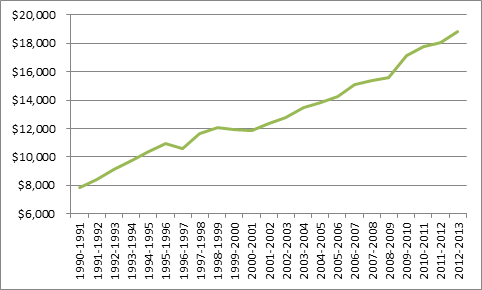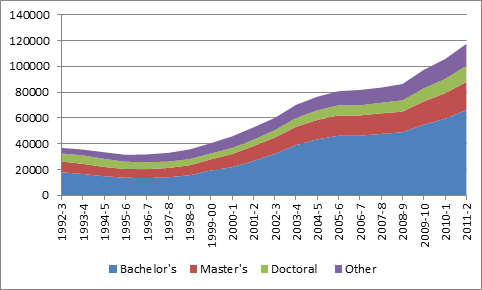A nice simple post today: why universities are going bananas for international students.
The first figure shows undergraduate tuition fees for international students in each province. They range from a little under $10,000 in Newfoundland, to just over $25,000 in PEI. The national average for this period is $18,840; in Ontario it is $23,000.
International Undergraduate Tuition Fees by Province, 2012, in $2013
What’s more, fees for international students have been going up quite steadily for two decades. Over the last 21 years, fees for international students have risen annually by an average of 4% in real terms (i.e. over and above inflation).
Average International Undergraduate Tuition Fees by Province, 1990-2012, in $2013
And these fee rises seem to have no effect on demand. Check out the rise in the number of international students. Is that great or what? High fees? Lots of international students. Raise fees? MORE International students!
International Student Enrolments, 1992-2011
Does anyone expect universities to turn down that kind of money, from an apparently inexhaustible source? Especially when the amount they get from government is flat, and tuition is tightly regulated?
OK, yes, the decision to take in international students is, in fact, marginally more complicated than I’m making it out to be here. I’ll get to that tomorrow. But the basic case for international students is right there in those three graphs.
Money talks, you know. Gotta pay the bills.




 Tweet this post
Tweet this post

Can you double check that PEI number? Our standard international student tuition and fees (aside from program specific fees) is currently $13,319 at the undergrad level. We do have grad programs that go well above that, but that is the rate for all undergrad programs. Unless you’re averaging in the DVM vet medicine fees, which are huge.
I’m just passing on Statscan data. The DVM fees are definitely averaged in there. How Statscan arrives at these averages is…obscure, let’s put it that way.
I am wondering if you will address where the extra money goes. What I’ve heard from institutions is that the extra tuition goes right back into services for international students so that the university isn’t really generating extra revenue per student. I do know that the added tuitions aren’t passed on to the faculties and programs that enrol them. Perhaps that will be in tomorrow’s post?
How institutions divvy up money will vary widely between institutions. There will be many places, such as Queen’s UT, which operate on a kind of eat-what-you-kill approach, where the funding (or a set portion thereof) most certainly would go back to the faculty of dept. But that wouldn’t be everywhere.
I think it came as a huge surprise to me that the demand for studying in Canada did increase so much despite rising tuition. At my institution several years ago, the international differential actually doubled, though current international students were grandfathered. The numbers didn’t lie: more international students were coming. But what I did observe was that that composition of those students changed. We lost students from Latin America and Africa, whose economies at that time were struggling much more than many of the countries in those regions today, but the brand loss was perhaps substantial as I haven’t seen the ratio equal out yet in the last 10 years. I suppose there are a number of factors that influence that, but it was noteworthy to me, nonetheless. What bugs me is the rhetoric around internationalisation. Those of us that work at these places know that the universities want the extra dollars, but they say publicly that they encourage internationalisation and to create diverse campuses. That diversity, at least on a cultural scale, was definitely compromised when our tuition increase favoured wealthier countries over poorer ones, and that leads to frightening questions about elitism and classism.